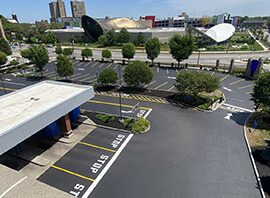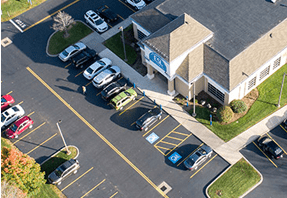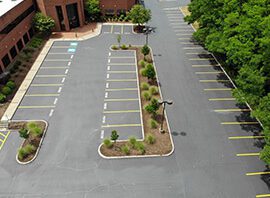Apr 13, 2025 | striper1800
Parking lot striping is a critical component in the development and functionality of parking facilities. It ensures organized vehicle parking, aids traffic flow, optimizes available space, and enhances safety. With the evolution of urban infrastructure and vehicular density, effective parking lot striping has become imperative. This article delves into the methodologies, compliance standards, best practices, and future directions of parking lot striping layouts.

Efficient parking lot striping is vital for optimizing space and providing clear instructions to drivers. According to the Federal Highway Administration (FHWA), proper striping can reduce vehicle collisions by up to 20%. Furthermore, a well-striped parking lot enhances aesthetic appeal and can improve property value by approximately 5-10%.
To ensure safety and uniformity, parking lot striping must adhere to specific standards and regulations. The U.S. Access Board provides guidelines on the dimensions of accessible parking spaces, which require a width of 8 feet for standard spaces, with a 5-foot wide access aisle. Due to legal liabilities, ensuring compliance with these regulations is crucial for property owners.
| Type of Space | Width (feet) | Length (feet) |
|---|---|---|
| Standard Space | 9 | 18 |
| Compact Space | 7.5 | 15 |
| Handicapped Space | 8 | 18 |
Different techniques and materials are used for parking lot striping depending on the climate, foot traffic, and maintenance schedules. The most commonly used are thermoplastic, which is known for its durability, and water-based paints, which are cost-effective and environmentally friendly. Regular maintenance, including re-striping every 1-2 years, is recommended to ensure visibility and safety.
To maximize the efficiency of a parking lot, layouts must be designed with attention to entry and exit points, flow of traffic, and integration of pedestrian walkways. According to industry research, diagonal striping can increase parking efficiency by up to 15% as it facilitates easier vehicle maneuvering and improves flow.

Technology plays an increasing role in parking lot design, with innovations like digital mapping and automated striping machines enhancing accuracy and reducing labor costs. GPS-enabled striping machines allow for precision and a uniformity that manual methods may lack.
Successful case studies, such as those in urban centers like Washington D.C., demonstrate the application of color coding and signage to aid both drivers and pedestrians. By using bold colors and symbols, such implementations can reduce confusion and enhance safety during peak traffic periods.
Environmentally conscious striping incorporates sustainable materials and practices. The use of low-VOC (Volatile Organic Compounds) paints and recycling of materials during resurfacing align with sustainability goals and reduce the carbon footprint of parking operations.
The future of parking lot striping is inclined towards the integration with smart technology and automated systems. There is potential growth in demand for reconfigurable striping solutions using LED-based systems that adjust according to peak usage times or changing traffic patterns.
With urban expansion, the availability of space is limited, making efficient planning essential. Techniques such as vertical stacking and modular parking structures are emerging to address these challenges in metropolitan areas.

Engaging professional striping services, such as Striper of East Fort Worth, ensures adherence to regulations, optimal functionality, and aesthetic appeal. Experts provide insights on the latest trends and materials, guaranteeing a future-proof parking solution.
In conclusion, parking lot striping plays a significant role in traffic management and safety. The evolution of materials and techniques indicates a shift towards eco-friendly and more efficient practices. Property owners and planners must stay informed about regulations and advancements to ensure compliant and efficient parking solutions.
Technology is increasingly integral to modern parking lot striping, enhancing accuracy, efficiency, and accountability. GPS-enabled striping machines provide precision, reducing human error and ensuring uniform line markings. Digital tools allow for better mapping and planning prior to striping, optimizing layouts and improving overall utility. Innovations in paint and materials technology have also led to more robust and longer-lasting striping solutions. Advanced monitoring systems can observe wear and tear, ensuring timely maintenance and re-striping to maintain safety and appearance.
For further information on parking lot striping or to consult with professionals, consider reaching out to services like Striper of East Fort Worth, known for expertise in compliant, efficient parking lot solutions.

Had our parking lot paved and found ourselves needing lines. Their team was fantastic from start to finish. They took the time to give great advice and listened closely to our company’s needs.

They are very responsive and complete the work in a timely fashion. I have used them for 18 years and have never had any issue with their work. Very highly recommended.

They are very easy to work with and have a highest level of attention to detail. They are very knowledgeable and passionate about parking lot striping. Their quality of work is outstanding!
COPYRIGHT © 1999-2025 | ALL RIGHTS RESERVED STRIPER INDUSTRIES, INC. | Privacy Policy